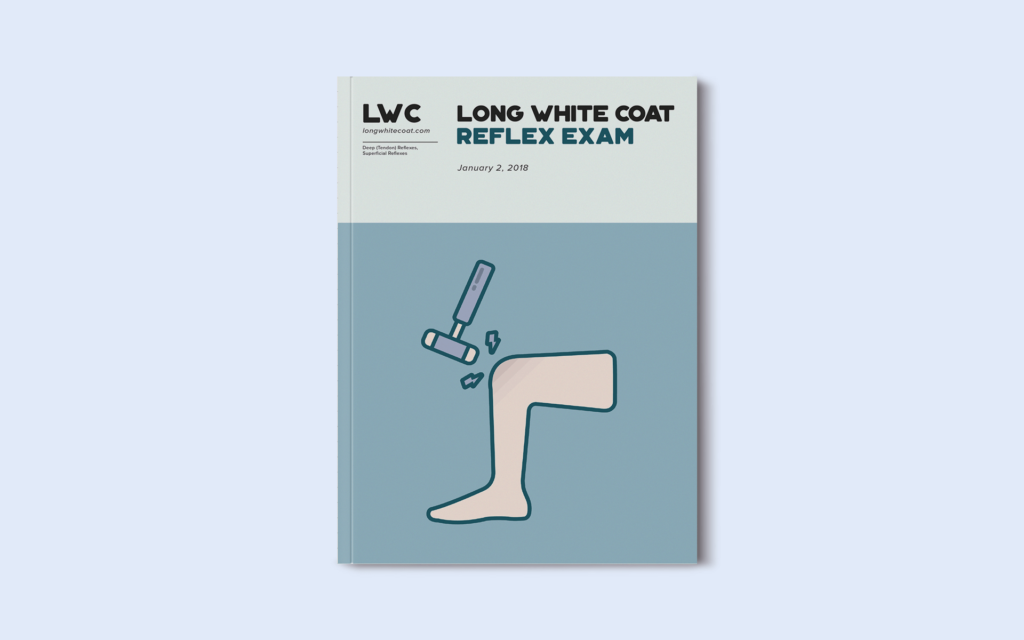

As an Amazon Associate Conductscience Inc earns revenue from qualifying purchases
Reflexes can broadly be categorized as deep (tendon) reflexes and superficial reflexes.
The deep (tendon) reflexes are monosynaptic stretch reflexes. They are tested through the use of a clinical hammer. Striking the clinical hammer against the tendon of the muscle elicits a sudden stretch impulse which can be observed as a contraction of the muscle. Abnormally brisk tendon reflexes indicate an upper motor neuron disorder, whereas an absence of tendon reflexes indicates disorders of sensory afferents from muscle spindles or LMN damage. As in neuropathy, motor neuron disease, poliomyelitis, and tabes dorsalis (it is possible for the sensory or motor component of the reflex arc to be affected in the absence of a tendon reflex). The following table shows the deep tendon reflexes which are assessed:
| Reflex | Nerve | Nerve root(s) | Technique | Clinical Correlation |
Biceps jerk
| Musculocutaneous
| C5, C6
| Flex the patient’s elbow at a right angle and place their forearm in a semipronated position. Place the thumb or index of your left hand over the tendon of the biceps in the cubital fossa and strike it with the hammer. Observe the contraction of the biceps tendon.
| Reduced or absent in radiculopathy or focal cord pathology at C5-C6 cord level
|
Supinator jerk
| Radial
| C5, C6
| This involves the brachioradialis muscle. Flex the patient’s forearm at the elbow and place it in a semipronated position. Bend their hand slightly towards the ulnar side. Strike the tendon of the brachioradialis, proximal to the styloid process of the radius. Observe the contraction.
| Mainly of interest when it is inverted*
|
Triceps jerk
| Radial
| C6, C7
| Place the patient’s forearm on their abdomen, and the elbow is flexed at the right angle. Strike the tendon of the triceps above the olecranon. Observe the contraction.
| Reduced or absent in high radial nerve lesion, radiculopathy, or focal cord pathology of the C6-C7 level.
|
Knee-jerk
| Femoral
| L3, L4
| The patient should be lying supine. Flex their knee and support it with your left hand. Feel for the tendon of the quadriceps and strike it between the patella and tibial tuberosity with the hammer. Observe the contraction of the quadriceps.
| Reduced in radiculopathy, lumbar plexopathy, or femoral neuropathy.
|
Ankle jerk
| Tibial branch of sciatic
| S1
| The patient should be lying supine. Flex their leg gently and place it in an externally rotated position. Place your left hand on the sole and dorsiflex it. Strike the Achilles tendon with the hammer. Observe the contraction of the calf muscles.
| Absence may be the only sign other than restricted straight leg raising in S1 radiculopathy due to L5/S1 disc prolapse.
|
*if a tendon jerk being elicited is absent or diminished, but there is the contraction of muscles innervated from an adjoining spinal segment, this is called inversion of that reflex. It indicates combined spinal cord and root pathology and has a precise localizing value. The inversion of the biceps or brachioradialis jerk would occur if the jerk is absent or diminished, but there is flexion of the fingers.
The following precautions should be taken when eliciting the tendon jerks:
Superficial reflexes are polysynaptic reflexes and include the following reflexes:
Plantar Reflex (S1)
The patient should lie supine with legs extended. Scratch the outer edge of the sole with some blunt object like a key, starting from the heel towards the little toe and then medially across the metatarsals. Stop as soon as the first movement of the toe occurs. The normal response is the plantar flexion of the great toe along with the flexion and adduction of the other toes. This is referred to as the negative Babinski’s sign. If there is dorsiflexion of the great toe along with fanning out of the other toes, it is referred to as the positive Babinski’s sign. A positive Babinski’s sign is present in UMN lesion, hypoglycemia, deep coma, post-epileptic fit, and also in infants.
Abdominal Reflex (T8-T12)
The patient should be lying in a supine position with a low pillow supporting the head. Draw a pin from the lateral part of the abdomen towards the midline on either side. It should be below and parallel to the costal margins for upper abdominal reflexes and above and parallel to the inguinal ligaments for lower abdominal reflexes. There should be a brisk contraction of the muscles of the stimulated area and movement of the umbilicus towards that side. Abdominal reflex is absent in UMN lesions above their segmental level or if there is an LMN lesion of the concerned spinal nerves.
Cremasteric Reflex (L1, L2)
Scratch the inner aspect of the upper part of the thigh. This should result in the elevation of the testes in male patients. This reflex is absent in UMN lesion.
Anal Reflex (S3, S4)
Scratch the skin near the anal margin with a sharp object. This should result in the contraction of the anal sphincter.
Corneal/conjunctival reflexes have already been described.
Due to the variation of power in individuals, it is important to compare both sides to detect weakness. The following grading method is used to classify the degree of weakness in the muscle group.
Grade 0
| No movement
|
Grade 1
| Barest flicker of movement of the muscle, though not enough to move the structure to which it’s attached.
|
Grade 2
| The voluntary movement is not sufficient to overcome the force of gravity. For example, the patient would be able to slide their hand across a table but not lift it from the surface.
|
Grade 3
| A voluntary movement capable of overcoming gravity, but not any applied resistance. For example, the patient could raise their hand off a table, but not if any additional resistance were applied.
|
Grade 4
| A voluntary movement capable of overcoming “some” resistance
|
Grade 5
| Normal strength
|
